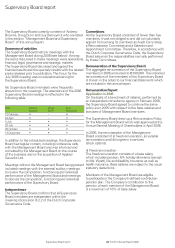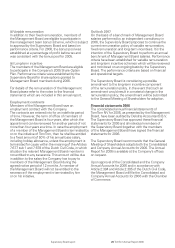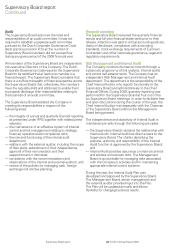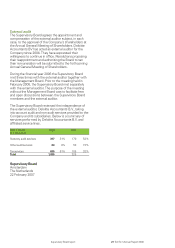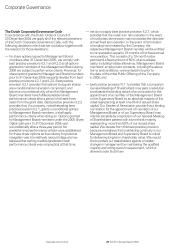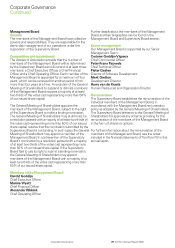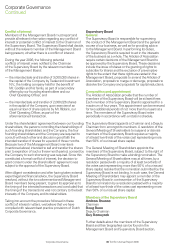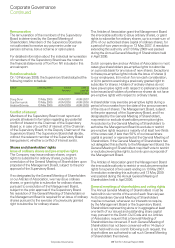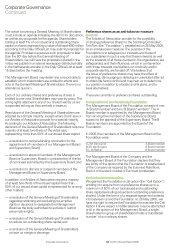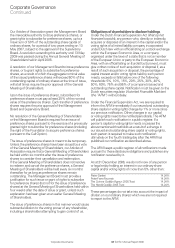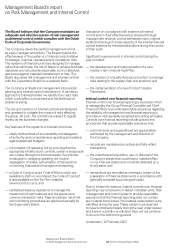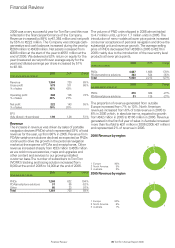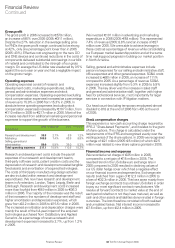TomTom 2006 Annual Report Download - page 28
Download and view the complete annual report
Please find page 28 of the 2006 TomTom annual report below. You can navigate through the pages in the report by either clicking on the pages listed below, or by using the keyword search tool below to find specific information within the annual report.Supervisory Board report 26 TomTom Annual Report 2006
Supervisory Board report
Continued
Audit
The Supervisory Board assumes the roles and
responsibilities of an audit committee. It was not
required to establish a separate audit committee
pursuant to the Dutch Corporate Governance Code
(best practice provision III.5) as the number of
Supervisory Board members did not exceed four
during any given period of the 2006 financial year.
All members of the Supervisory Board are independent
non-executive Directors of the Company. The Dutch
Corporate Governance Code requires the Supervisory
Board to be satisfied that at least one member is a
financial expert. The Supervisory Board considers that
there is a sufficient breadth of financial expertise across
the Supervisory Board that, collectively, the members
have the requisite skills and attributes to enable them
to properly discharge their responsibilities relating to
the business of an audit committee.
The Supervisory Board assisted the Company in
meeting its responsibilities in respect of the
following areas:
— the integrity of annual and quarterly financial reporting
as presented under IFRS together with related press
releases;
— the maintenance of an effective system of internal
control and risk management relating to strategic,
financial, operational and compliance risks;
— the role and functioning of the internal audit
department;
— relations with the external auditor, including the scope
of their plans, assessment of their independence,
approval of their remuneration and their
reappointment or dismissal;
— compliance with the recommendations and
observations of the internal and external auditors; and
— review of the policies for managing cash, foreign
exchange risk and tax planning.
Financial reporting
The Supervisory Board reviewed the quarterly financial
results and full-year financial statements prior to their
release. Attention was paid to critical accounting policies,
clarity of disclosure, compliance with accounting
standards, stock exchange requirements of Euronext
Amsterdam and other corporate governance, legal and
regulatory requirements.
Risk Management and Internal Audit
The Company monitors its internal controls through a
systematic programme of risk analysis, internal audits
and control self-assessments. The Company has an
independent Risk Management and Internal Audit
department. The department is the responsibility of the
Chief Internal Auditor who reports functionally to the
Supervisory Board and administratively to the Chief
Financial Officer. During 2006, quarterly reporting was
performed for the Supervisory Board at four out of the
six Supervisory Board meetings. In order to facilitate free
and open discussions during the course of the year, the
Chief Internal Auditor met separately with the Chairman
of the Supervisory Board without the Management
Board being present.
The independence and objectivity of Internal Audit is
maintained primarily through the following principles:
— the Supervisory Board maintains the relationship with
Internal Audit. Internal Audit has direct access to the
Supervisory Board. The charter describing the
purpose, authority and responsibility of the Internal
Audit function is approved by the Supervisory Board;
and
— Internal Audit provides assurance on internal controls
and advises on business risks. The Management
Board is accountable for managing risks associated
with the Company’s activities and for maintaining
appropriate internal control systems.
During the year, the Internal Audit Plan was
developed and approved by the Supervisory Board.
The Management Board, senior management and
the external auditor provided input into the Plan.
The Plan will be updated annually and allows
flexibility for changing business needs.










